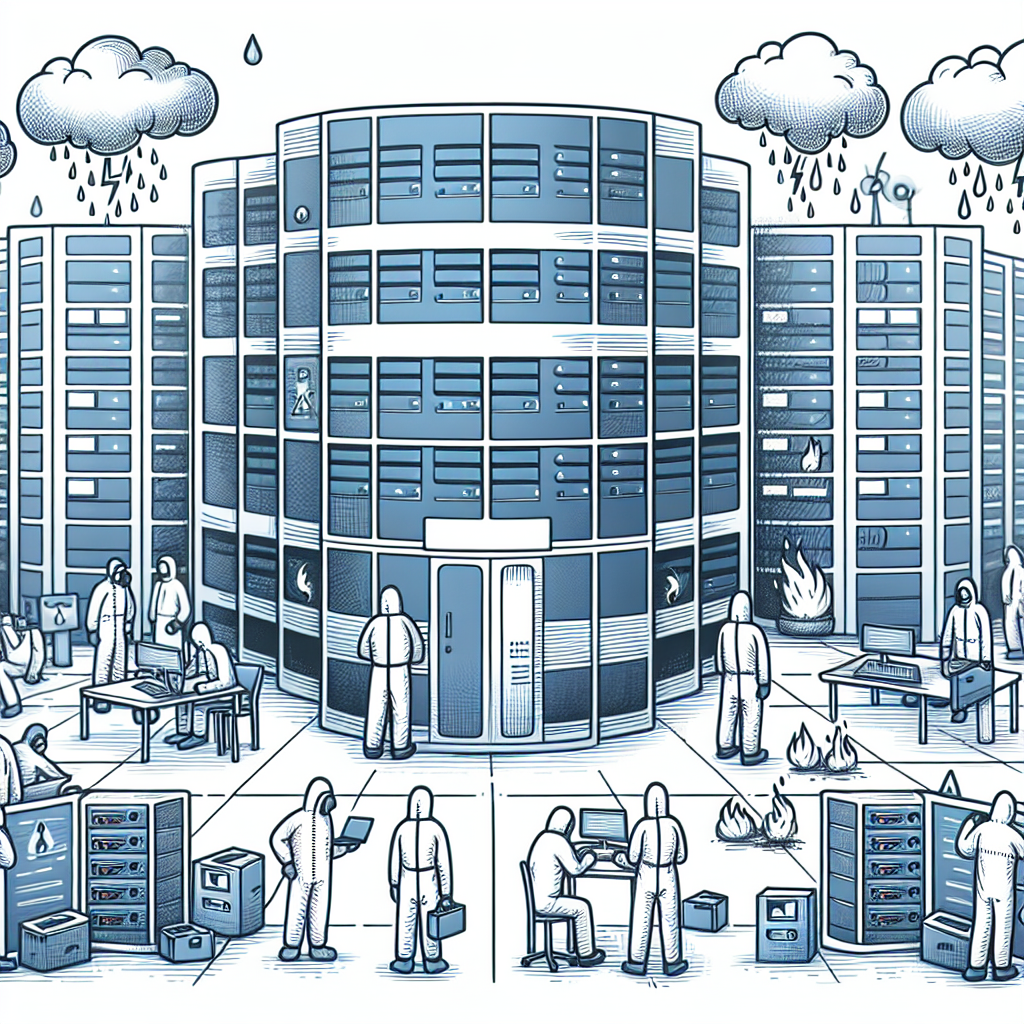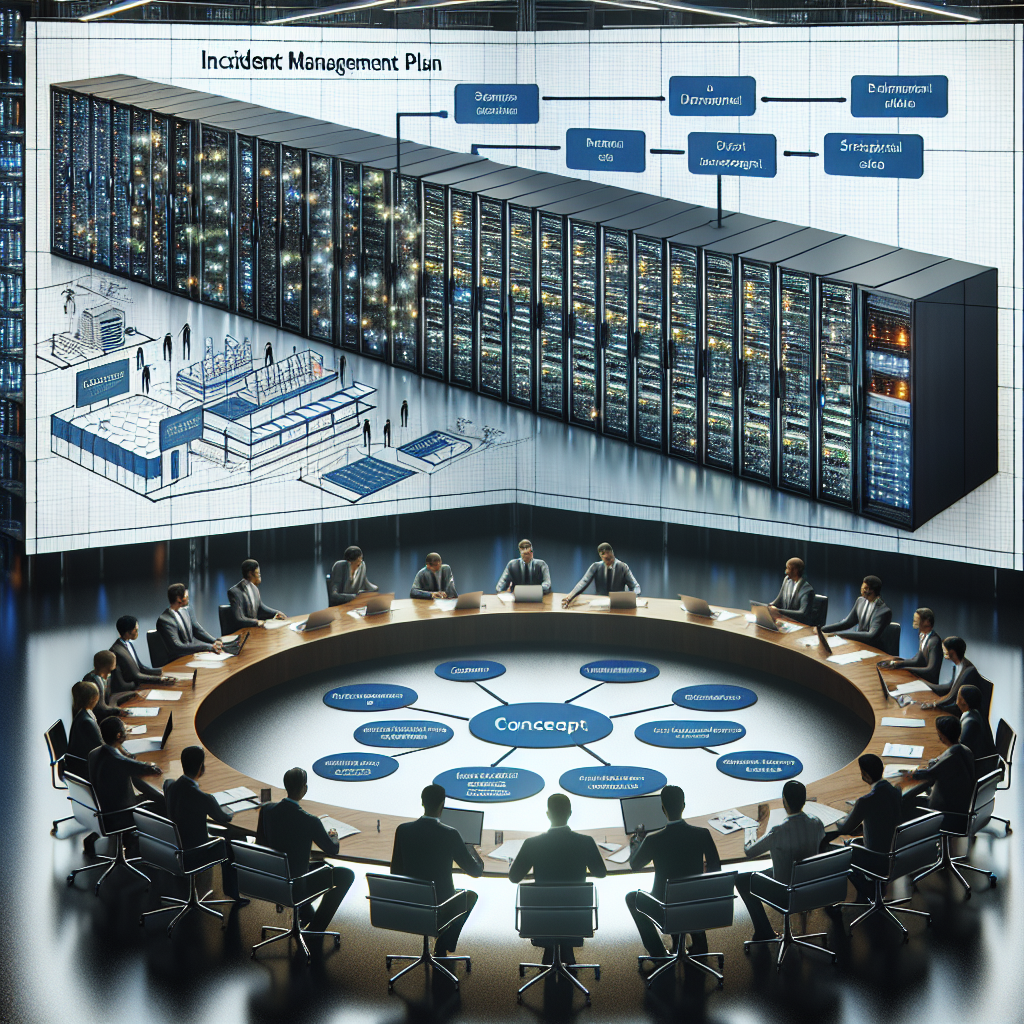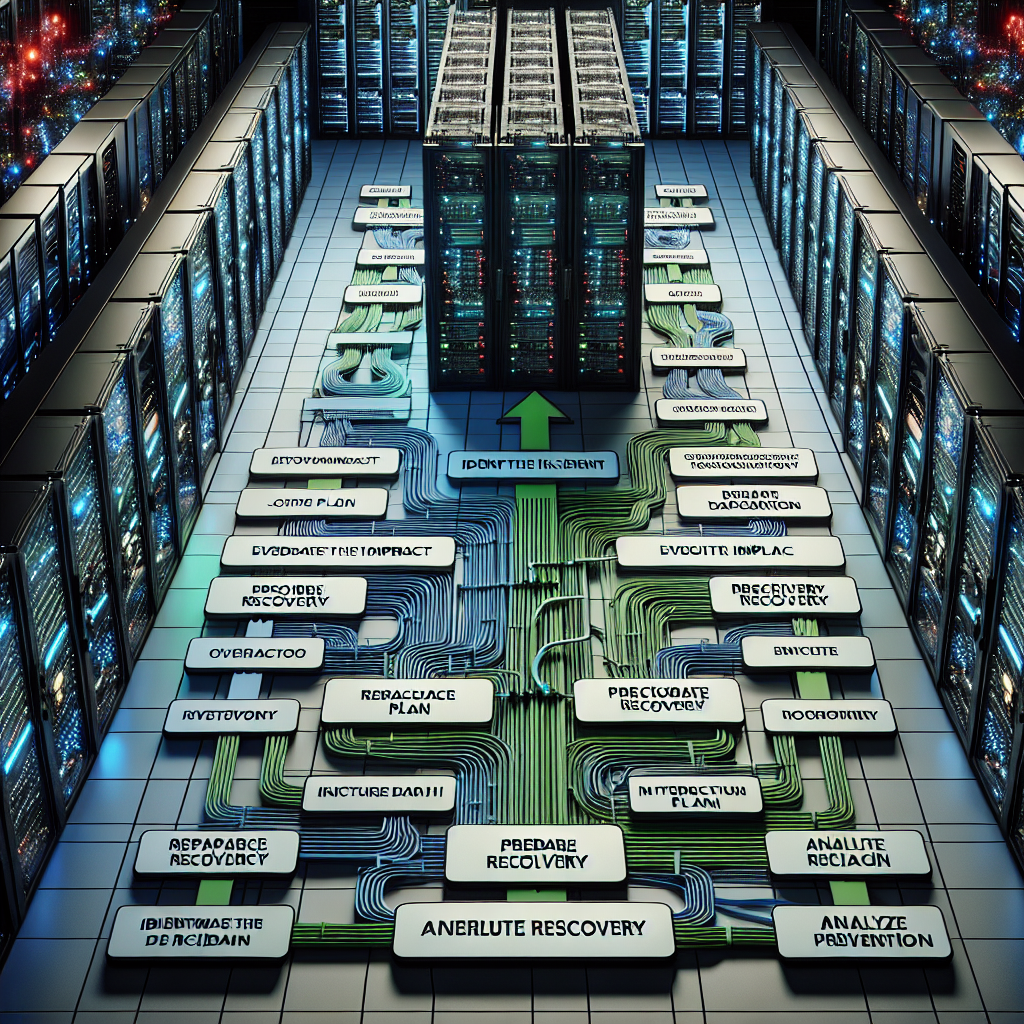Your cart is currently empty!
Tag: Data Center Incident Management

Navigating the Challenges of Data Center Incident Response
Data centers are the heart of any organization’s IT infrastructure, housing critical data and applications that keep businesses running smoothly. However, with the increasing complexity and volume of cyber threats, data center incidents are becoming more common and more challenging to navigate. In this article, we will explore some of the key challenges that organizations face when responding to data center incidents and provide some best practices for effectively managing and mitigating these incidents.One of the biggest challenges in data center incident response is the sheer volume of alerts and notifications that IT teams receive on a daily basis. With so many different systems and applications generating alerts, it can be difficult for teams to prioritize and respond to incidents in a timely manner. This can lead to delays in identifying and containing threats, increasing the risk of a data breach or outage.
Another challenge is the complexity of modern data center environments. With many organizations using a combination of on-premises, cloud, and hybrid infrastructure, it can be challenging to quickly identify and contain incidents that span multiple platforms. This can lead to confusion and miscommunication among IT teams, further delaying the incident response process.
Additionally, many organizations struggle with a lack of visibility into their data center environments. Without a clear understanding of the systems and applications that make up their infrastructure, IT teams may struggle to effectively detect and respond to incidents. This can leave organizations vulnerable to prolonged downtime and data loss.
To effectively navigate these challenges, organizations should implement a comprehensive incident response plan that outlines roles and responsibilities, defines incident severity levels, and establishes clear communication channels. This plan should also include procedures for quickly identifying and containing incidents, as well as guidelines for documenting and reporting on incident response activities.
Furthermore, organizations should invest in monitoring and alerting tools that provide real-time visibility into their data center environments. These tools can help IT teams quickly identify and respond to incidents, reducing the risk of data loss and downtime. Additionally, organizations should regularly conduct incident response drills and simulations to test their response capabilities and identify areas for improvement.
In conclusion, navigating the challenges of data center incident response requires a proactive and strategic approach. By implementing a comprehensive incident response plan, investing in monitoring and alerting tools, and conducting regular drills and simulations, organizations can effectively manage and mitigate data center incidents, reducing the risk of data breaches and downtime.

The Impact of Data Center Incidents on Overall Business Operations
Data centers play a crucial role in today’s digital world, serving as the backbone of countless businesses and organizations. These facilities house and manage a vast amount of critical data and applications that are essential for daily operations. However, like any other complex system, data centers are not immune to incidents and downtime. When a data center experiences an outage or failure, the impact on overall business operations can be significant and far-reaching.One of the primary consequences of a data center incident is disruption to services and applications. When a data center goes down, it can lead to a loss of access to critical systems and data, causing delays in operations and potentially halting business activities altogether. This can have a domino effect on other departments and processes within the organization, leading to decreased productivity and revenue loss.
Data center incidents can also have a damaging effect on customer satisfaction. If customers are unable to access the services or products they rely on due to a data center outage, it can lead to frustration and dissatisfaction. In today’s competitive market, where customer experience is paramount, any disruption in service can result in a loss of customers and damage to the organization’s reputation.
Furthermore, data center incidents can also have financial implications for businesses. Downtime can result in direct losses in terms of revenue and productivity, as well as indirect costs associated with repairing the data center infrastructure and restoring operations. In addition, businesses may also incur penalties and fines for failing to meet service level agreements or regulatory requirements.
In today’s digital economy, where data is a valuable asset, the impact of data center incidents on overall business operations cannot be underestimated. It is essential for organizations to have robust disaster recovery and business continuity plans in place to mitigate the impact of data center incidents and ensure the continuity of operations. This includes implementing redundant systems, regular testing of backup and recovery processes, and monitoring and addressing potential vulnerabilities in the data center infrastructure.
In conclusion, data center incidents can have a profound impact on overall business operations, leading to disruptions in services, loss of revenue, damage to customer satisfaction, and financial implications. It is essential for businesses to prioritize the resilience and reliability of their data center infrastructure to minimize the risk of downtime and ensure the continuity of operations. By investing in robust disaster recovery and business continuity measures, organizations can better prepare for and mitigate the impact of data center incidents on their business.

Mitigating Risk with Proactive Incident Management in Data Centers
Data centers are the backbone of modern businesses, providing the infrastructure needed to store, process, and manage data critical to operations. However, with the increasing complexity and scale of data center environments, the risk of incidents and downtime has also grown. To mitigate these risks and ensure continuous operations, proactive incident management strategies are essential.Proactive incident management involves identifying potential risks, implementing preventive measures, and establishing effective response plans to minimize the impact of incidents. By taking a proactive approach, data center operators can reduce the likelihood of downtime, data loss, and service disruptions.
One key aspect of proactive incident management in data centers is risk assessment. This involves identifying potential threats and vulnerabilities that could lead to incidents such as power outages, hardware failures, cyber attacks, and human errors. By conducting regular risk assessments, data center operators can prioritize areas for improvement and allocate resources effectively to mitigate these risks.
Another important aspect of proactive incident management is the implementation of preventive measures. This includes implementing redundancy and failover mechanisms to minimize the impact of hardware failures, conducting regular maintenance and testing of critical systems, and implementing security measures to protect against cyber attacks. By proactively addressing potential vulnerabilities, data center operators can reduce the likelihood of incidents occurring.
In addition to preventive measures, having effective incident response plans in place is crucial for mitigating risks in data centers. These plans outline the steps to be taken in the event of an incident, including who is responsible for responding, how to communicate with stakeholders, and what actions need to be taken to restore operations. By having clear and well-defined incident response plans, data center operators can minimize the impact of incidents and ensure a quick recovery.
Furthermore, continuous monitoring and analysis of data center operations are essential for proactive incident management. By monitoring key performance indicators and analyzing trends, data center operators can identify potential issues before they escalate into major incidents. This allows for timely intervention and proactive measures to be taken to prevent downtime and disruptions.
In conclusion, proactive incident management is essential for mitigating risks in data centers and ensuring continuous operations. By conducting risk assessments, implementing preventive measures, establishing effective incident response plans, and continuously monitoring operations, data center operators can reduce the likelihood of incidents occurring and minimize their impact. Ultimately, proactive incident management is key to maintaining the reliability, availability, and security of data center environments.

Key Steps for Improving Incident Response in Data Centers
Data centers play a crucial role in the functioning of modern businesses, housing the servers and infrastructure that store and process vast amounts of data. With cyber threats on the rise, it is essential for data center operators to have robust incident response procedures in place to quickly and effectively address any security incidents that may occur.Here are key steps that data center operators can take to improve their incident response capabilities:
1. Develop a comprehensive incident response plan: The first step in improving incident response in data centers is to develop a detailed incident response plan. This plan should outline the roles and responsibilities of all staff involved in incident response, as well as the steps to be taken in the event of a security incident. It should also include protocols for communication, escalation, and coordination with external stakeholders such as law enforcement and regulatory authorities.
2. Conduct regular training and drills: Once an incident response plan is in place, it is essential to ensure that all staff are trained in their roles and responsibilities. Regular training sessions and drills can help to familiarize staff with the plan and ensure that they are prepared to respond effectively in the event of an incident. These training sessions should cover a range of scenarios, including cyber attacks, physical security breaches, and natural disasters.
3. Implement monitoring and alerting systems: Monitoring and alerting systems can help data center operators to detect security incidents in real-time and respond quickly before they escalate. These systems can include intrusion detection systems, security information and event management (SIEM) tools, and network monitoring tools. By implementing these systems, data center operators can proactively monitor their infrastructure and identify potential security threats before they cause significant damage.
4. Establish a dedicated incident response team: In larger data centers, it can be beneficial to establish a dedicated incident response team responsible for coordinating the response to security incidents. This team should be made up of individuals with expertise in areas such as cybersecurity, network infrastructure, and physical security. By having a dedicated team in place, data center operators can ensure a swift and coordinated response to security incidents.
5. Conduct post-incident reviews and continuous improvement: After responding to a security incident, it is important to conduct a post-incident review to identify any gaps or weaknesses in the incident response plan. This review should include an analysis of what went well during the response, as well as areas for improvement. By continuously reviewing and updating the incident response plan, data center operators can improve their incident response capabilities over time.
In conclusion, improving incident response in data centers is essential for protecting the sensitive data and infrastructure housed within these facilities. By following the key steps outlined above, data center operators can enhance their incident response capabilities and better protect their organization from security threats.

Common Data Center Incidents and How to Respond
Data centers are critical components of modern businesses, housing servers, networking equipment, and storage systems that store and process vast amounts of data. However, data centers are also vulnerable to various incidents that can disrupt operations and potentially lead to data loss. In this article, we will discuss some common data center incidents and how to respond to them effectively.1. Power Outages
Power outages are a common occurrence in data centers and can have a significant impact on operations. To respond to a power outage, data center operators should have backup power systems in place, such as uninterruptible power supply (UPS) units or diesel generators. These backup systems can provide temporary power to critical equipment until the main power supply is restored. Additionally, data center staff should regularly test backup power systems to ensure they are functioning correctly.
2. Cooling System Failures
Cooling systems are essential to maintaining optimal temperatures in data centers and preventing equipment from overheating. A cooling system failure can lead to equipment failure and data loss. To respond to a cooling system failure, data center operators should have redundant cooling systems in place to provide backup cooling capacity in case of a failure. Regular maintenance and monitoring of cooling systems can also help prevent failures from occurring.
3. Network Outages
Network outages can disrupt connectivity between servers, storage systems, and other networked devices in a data center. To respond to a network outage, data center operators should have redundant network connections in place to provide backup connectivity in case of a failure. Additionally, monitoring tools can help identify and troubleshoot network issues quickly to minimize downtime.
4. Physical Security Breaches
Physical security breaches, such as unauthorized access to data center facilities, can compromise the security of data and equipment. To respond to a physical security breach, data center operators should have robust access control measures in place, such as biometric authentication and security cameras. In the event of a breach, security personnel should be alerted immediately, and the breach should be investigated to determine the extent of the intrusion.
5. Equipment Failures
Equipment failures, such as server crashes or storage system malfunctions, can lead to data loss and downtime. To respond to equipment failures, data center operators should have spare equipment on hand to quickly replace failed components. Regular maintenance and monitoring of equipment can also help identify potential issues before they lead to failures.
In conclusion, data center incidents are a reality that data center operators must be prepared to respond to effectively. By implementing robust backup systems, monitoring tools, and security measures, data center operators can minimize the impact of incidents and ensure the continued operation of critical systems. Regular testing and maintenance of systems are also essential to prevent incidents from occurring in the first place. By being proactive and prepared, data center operators can effectively respond to common incidents and safeguard their data and operations.

How to Develop a Comprehensive Incident Management Plan for Data Centers
Data centers are the backbone of modern businesses, storing and processing vast amounts of critical data. With the increasing complexity and volume of data being handled, it is essential for data center operators to have a comprehensive incident management plan in place to mitigate the risks of potential disruptions or disasters.Developing a comprehensive incident management plan for data centers involves a systematic approach that identifies potential risks, establishes procedures for responding to incidents, and ensures minimal downtime and data loss in the event of an emergency. Here are some key steps to consider when developing an incident management plan for data centers:
1. Identify potential risks: The first step in developing an incident management plan is to identify potential risks that could disrupt operations in the data center. This includes natural disasters such as earthquakes, floods, or fires, as well as human errors, cyber-attacks, and equipment failures.
2. Assess impact: After identifying potential risks, it is important to assess the potential impact of each risk on data center operations. This includes evaluating the potential data loss, downtime, financial losses, and reputational damage that could result from each incident.
3. Establish response procedures: Once the potential risks and their impact have been assessed, it is important to establish clear and detailed response procedures for each type of incident. This includes assigning roles and responsibilities to key personnel, establishing communication protocols, and outlining the steps to be taken to mitigate the impact of the incident.
4. Test and refine the plan: Developing an incident management plan is not a one-time activity. It is important to regularly test and refine the plan to ensure that it remains effective and up-to-date. This includes conducting simulated exercises, tabletop drills, and post-incident reviews to identify areas for improvement.
5. Communicate the plan: Once the incident management plan has been developed and tested, it is crucial to communicate the plan to all relevant stakeholders, including data center staff, vendors, customers, and emergency responders. This ensures that everyone is aware of their roles and responsibilities in the event of an incident.
In conclusion, developing a comprehensive incident management plan for data centers is essential for ensuring the continued operation and security of critical data. By identifying potential risks, assessing their impact, establishing response procedures, testing and refining the plan, and communicating it to all stakeholders, data center operators can minimize the risks of disruptions and disasters and ensure business continuity in the face of emergencies.

Ensuring Business Continuity: Incident Management in Data Centers
In today’s digital age, data centers play a crucial role in ensuring business continuity for organizations of all sizes. These facilities house critical IT infrastructure, including servers, storage devices, and networking equipment, that store and process vast amounts of data. As such, it is essential for businesses to have robust incident management processes in place to prevent disruptions and minimize downtime in the event of unforeseen events.Incidents in data centers can range from power outages and hardware failures to cyber attacks and natural disasters. Regardless of the cause, the impact of an incident can be significant, leading to data loss, system downtime, and financial losses. To mitigate these risks, organizations must have a well-defined incident management plan that outlines procedures for identifying, responding to, and resolving incidents in a timely and effective manner.
One of the key components of incident management in data centers is proactive monitoring and alerting. By implementing monitoring tools that track the performance and health of IT infrastructure, organizations can detect potential issues before they escalate into major incidents. Alerts can be set up to notify IT staff of abnormalities in system behavior, such as high CPU usage, low disk space, or network congestion, allowing them to take corrective action before users are impacted.
In addition to monitoring, data centers should have a designated incident response team responsible for coordinating the response to incidents. This team should consist of IT professionals with the necessary skills and expertise to troubleshoot and resolve technical issues efficiently. Clear communication channels and escalation procedures should be established to ensure that incidents are reported and addressed promptly.
Furthermore, organizations should conduct regular incident response drills to test the effectiveness of their incident management plan. These exercises simulate various scenarios, such as a server outage or a security breach, to evaluate the team’s response and identify areas for improvement. By practicing incident response procedures in a controlled environment, organizations can better prepare for real-world incidents and minimize the impact on business operations.
Finally, data centers should have redundancy and failover mechanisms in place to ensure continuity of operations in the event of a major incident. This includes redundant power supplies, backup generators, and failover systems that can quickly take over in case of a hardware failure or network outage. By implementing these measures, organizations can minimize downtime and maintain business continuity even in the face of unexpected events.
In conclusion, incident management is a critical aspect of ensuring business continuity in data centers. By implementing proactive monitoring, establishing a response team, conducting regular drills, and implementing redundancy measures, organizations can effectively manage incidents and minimize the impact on their operations. With a well-defined incident management plan in place, organizations can better protect their data center infrastructure and ensure the availability and reliability of their IT systems.

Navigating Data Center Incidents: A Roadmap for Response and Recovery
In today’s increasingly digital world, data centers play a crucial role in storing and managing vast amounts of information for businesses and organizations. However, data center incidents can and do occur, posing a significant threat to the security and integrity of valuable data. In order to effectively respond to and recover from these incidents, it is essential for data center operators to have a clear roadmap in place.Navigating data center incidents requires a strategic and comprehensive approach that encompasses both response and recovery efforts. By following a roadmap for incident management, data center operators can minimize the impact of incidents and ensure the continuity of operations.
The first step in navigating data center incidents is to establish a comprehensive incident response plan. This plan should outline the roles and responsibilities of key personnel, as well as the procedures for detecting, assessing, and responding to incidents. It should also include communication protocols for notifying stakeholders and coordinating response efforts.
In the event of a data center incident, it is crucial to quickly assess the situation and determine the extent of the damage. This may involve conducting a thorough investigation to identify the root cause of the incident and assess the impact on data and systems. By promptly identifying and containing the incident, data center operators can prevent further damage and minimize downtime.
Once the incident has been contained, the focus shifts to recovery efforts. This may involve restoring data and systems, as well as implementing additional security measures to prevent future incidents. It is important to prioritize critical systems and data during the recovery process, as well as to regularly test and update backup and recovery procedures to ensure their effectiveness.
Throughout the incident response and recovery process, communication is key. Data center operators should keep stakeholders informed of the situation, including the status of recovery efforts and any potential impacts on operations. By maintaining open and transparent communication, data center operators can build trust with stakeholders and demonstrate their commitment to mitigating the impact of incidents.
In conclusion, navigating data center incidents requires a proactive and strategic approach that encompasses both response and recovery efforts. By establishing a comprehensive incident response plan, promptly detecting and containing incidents, and communicating effectively with stakeholders, data center operators can minimize the impact of incidents and ensure the continuity of operations. By following a roadmap for incident management, data center operators can navigate even the most challenging incidents with confidence and resilience.

Preparing for Data Center Incidents: Proactive Measures to Minimize Risk
Data centers are the backbone of modern businesses, housing critical infrastructure and sensitive data. However, as data centers become increasingly complex and interconnected, the risk of incidents and disruptions also grows. From power outages to cyberattacks, data center incidents can have serious consequences for businesses, resulting in data loss, downtime, and financial losses.To mitigate these risks and ensure the continuity of operations, it is essential for organizations to take proactive measures to prepare for data center incidents. By implementing robust incident response plans and adopting best practices, businesses can minimize the impact of incidents and maintain the integrity and availability of their data.
One of the first steps in preparing for data center incidents is to conduct a thorough risk assessment. This involves identifying potential threats and vulnerabilities that could affect the data center, such as power outages, equipment failures, natural disasters, and cyberattacks. By understanding the risks that the data center faces, organizations can develop targeted strategies to mitigate these threats and minimize the likelihood of incidents occurring.
Once the risks have been identified, organizations should develop comprehensive incident response plans that outline the steps to be taken in the event of a data center incident. These plans should include protocols for detecting and responding to incidents, as well as procedures for restoring operations and recovering data. By having a clear roadmap for responding to incidents, organizations can minimize downtime and ensure a swift recovery.
In addition to incident response plans, organizations should also implement proactive measures to prevent incidents from occurring in the first place. This can include regular maintenance and testing of equipment, implementing cybersecurity measures to protect against cyberattacks, and ensuring that data center staff are trained in best practices for data center security.
Regularly reviewing and updating incident response plans is also crucial to ensure that they remain effective in the face of evolving threats. By conducting regular drills and exercises, organizations can test the effectiveness of their plans and identify areas for improvement. This proactive approach can help organizations to stay ahead of potential incidents and minimize their impact on operations.
Ultimately, preparing for data center incidents requires a proactive and multi-faceted approach that combines risk assessment, incident response planning, and proactive measures to prevent incidents. By taking these steps, organizations can minimize the risk of data center incidents and ensure the continuity of their operations in the face of potential threats.

How to Handle Data Center Incidents: Tips and Techniques
Data centers are the heart of an organization’s IT infrastructure, housing critical data and applications that are essential for day-to-day operations. However, data center incidents can occur unexpectedly, disrupting business operations and causing downtime. As a data center manager or IT professional, it is crucial to have a plan in place to handle incidents effectively and minimize the impact on the organization. Here are some tips and techniques for handling data center incidents:1. Establish an Incident Response Plan: The first step in handling data center incidents is to establish an incident response plan. This plan should outline the procedures and protocols to follow in the event of an incident, including who to contact, how to communicate with stakeholders, and how to mitigate the impact of the incident. Make sure all team members are familiar with the plan and conduct regular drills to test its effectiveness.
2. Monitor and Detect Incidents: Monitoring tools can help you detect incidents in real-time and alert you to potential issues before they escalate. Implementing a robust monitoring system that tracks key performance metrics, such as server uptime, network traffic, and storage capacity, can help you identify and address issues proactively.
3. Prioritize Incidents: Not all incidents are created equal, and it’s important to prioritize them based on their severity and impact on business operations. Use a triage system to categorize incidents into different levels of severity, with a corresponding response plan for each level. This will help you allocate resources effectively and focus on resolving the most critical incidents first.
4. Communicate Effectively: Clear communication is key during a data center incident. Keep stakeholders informed about the incident, its impact on operations, and the steps being taken to resolve it. Establish a communication plan that outlines who should be notified, when updates should be provided, and how information should be disseminated.
5. Collaborate with Cross-Functional Teams: Data center incidents often require collaboration between IT teams, security teams, vendors, and other stakeholders. Establishing cross-functional incident response teams can help streamline communication and coordination during an incident. Make sure team members are trained on their roles and responsibilities and practice working together in simulated scenarios.
6. Document and Review Incidents: After an incident has been resolved, it’s important to document what happened, the steps taken to resolve it, and any lessons learned. Conduct a post-incident review to analyze the root cause of the incident, identify areas for improvement, and update the incident response plan accordingly. This will help you learn from past incidents and prevent similar issues from occurring in the future.
By following these tips and techniques, you can effectively handle data center incidents and minimize the impact on your organization’s operations. Remember to stay calm, communicate clearly, and work collaboratively with your team to resolve incidents quickly and efficiently. With a well-defined incident response plan in place, you can ensure that your data center remains secure and resilient in the face of unexpected challenges.
